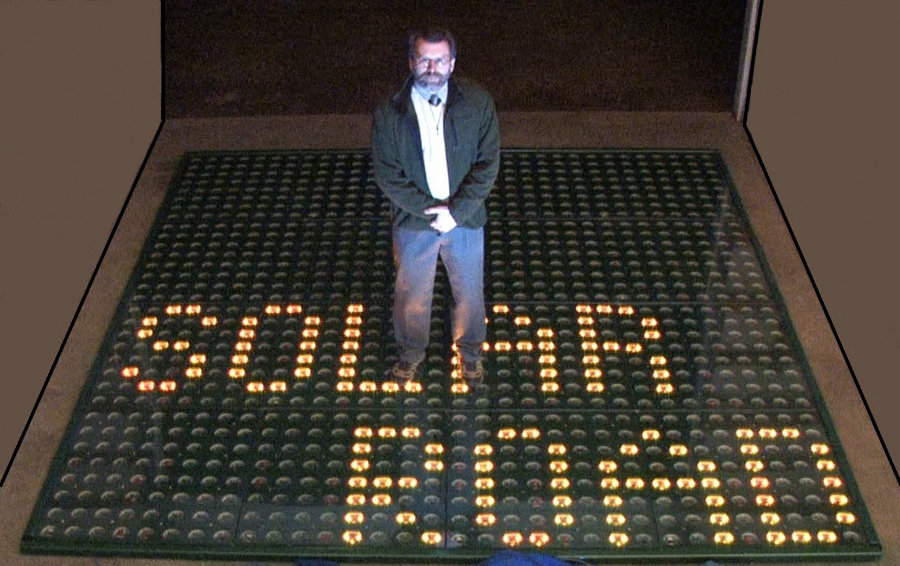March 15, 2012


There are currently 28,000 square miles of roadways and driving surfaces spread across the lower 48 states. With the cost and availability of traditional paving materials becoming an issue, innovator Scott Brusaw, an electrical engineer (MSEE) with over 20 years of industry experience, sees solar highways as the solution. (Photo by Mark Dixon, Yert.com)
[nggallery id=130 template=carousel images=8][imagebrowser id=130] By Debra Atlas March 15, 2011
SANDPOINT, ID— There are 28,000 square miles of roadways spread across the 48 continental states. With the cost of traditional paving materials going up and their availability going down, innovator Scott Brusaw sees solar highways as the solution to several energy and transportation problems.
Brusaw is an electrical engineer (MSEE) with over 20 years of industry experience, and is the co-founder of Idaho-based Solar Roadways Incorporated. His solar roadway concept won a $50,000 Community Award from the 2010 GE Ecomagination Challenge, and also received the most community votes in the 2011 event.
Brusaw’s 12 x12 ft solar road prototype incorporates an array of solar panels. Each panel includes three yellow and three white LEDs, with just over 6,000 LEDs in the whole prototype. The system’s internal microprocessor determines which LEDs light up, allowing the mechanism to spell out almost any message.
Once the first phase of the Small Business Innovative Research (SBIR) contract was completed, the Federal Highway Administration awarded Brusaw’s company a $750,000 Phase II SBIR contract in July 2011. That equals roughly two years’ worth of funding for solar streets, according to Brusaw.
Phase II involves building a parking lot paved with embedded solar panels outside of the company’s electronics lab in Sandpoint, Idaho. The plan is to break ground for the parking lot next month, but that’s only if Mother Nature cooperates.
“Right now, there’s snow and ice on the ground,” explains Brusaw.
[youtube]ONB9rp_Msp8[/youtube]
Brusaw is working with several universities across the country to solve complex issues relating to this project, including the type of glass to use. The glass must be durable and strong enough to be driven on, and also allow for optimal solar charging. Where can one find such glorious glass?
That’s where Joel Berman comes in. His company, Joel Berman Glass Studios, Ltd, previously created the glass sidewalk panels across New York City’s Madison Square Garden. This ticker-tape-shaped marquee was installed across from the main entrance to Penn Station in 2007. Berman says that making glass an accessible road surface that creates electricity or communicates a message is a huge game changer in how we perceive our driving and walking surfaces.
“Millions of people have walked over it. It’s a historical blend of art and science,” says Berman.
Berman’s glass panels had to pass the Americans with Disabilities Act requirements for pedestrian surfaces: successfully accommodate rain, the weight of wheelchairs, etc. Brusaw took samples of different types of glass from Berman and shipped them to the glass-testing facility at the University of Toledo in Ohio.
Results showed that the first type of glass was good for vehicles traveling up to 40 mph on a wet surface, but needed more traction in order to be safe for 70+ mph traffic. So Brusaw went back to the drawing board. The next type of glass passed all traffic requirements.
Another key issue is the translucence of the glass panels. You have to make the glass surface rough enough for a car to be able to stop safely on it, but not so rough that it stops sunlight from reaching the solar cells beneath. According to Brusaw, the glass sidewalk sample was clear enough that “you can lay it on top of a book and read through it.” However, the team still needs to test how well sunlight reaches the solar cells.
Once completed, the system could produce three times more electricity than the country currently uses.
Each 12-foot solar panel would generate 7.6 kilowatt hours of electricity per day, so it would only take four of these panels to supply the electrical needs of a typical household. The electricity could be used to melt snow and ice, spell warnings for motorists, and/ or to power a crosswalk that lights up when a pedestrian steps on the street. According to Brusaw, solar roadways could eliminate the need for oil, coal, and natural gas if a significant portion of the country was paved with them.
So how are we going to get solar roadways across the states? Tomorrow, Sierra Club Green Home will give you the scoop on Brusaw’s unique business model and his vision for solar roadways worldwide.
For related article, see: Smart Grid: Smart Idea More articles by Debra Atlas
© 2012 SCGH, LLC.
]]>